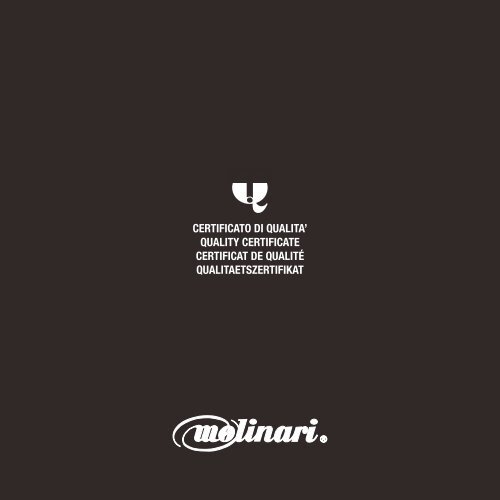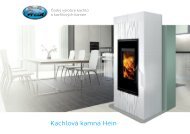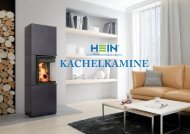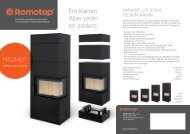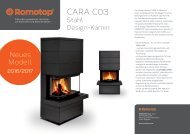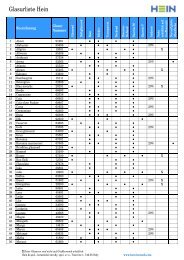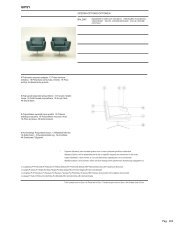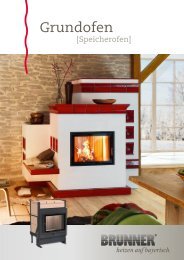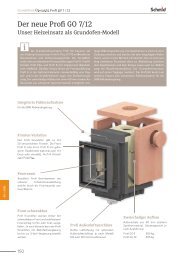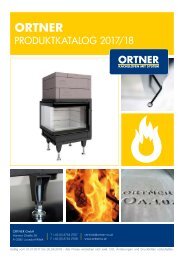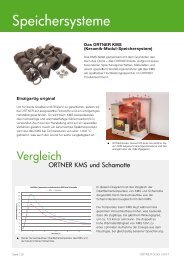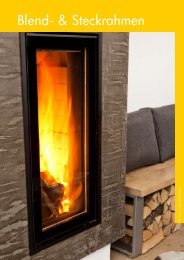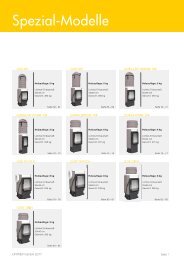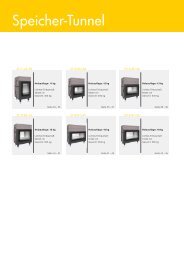CQmolinari2011cc
You also want an ePaper? Increase the reach of your titles
YUMPU automatically turns print PDFs into web optimized ePapers that Google loves.
Q<br />
Q<br />
certificato di qualita’<br />
Quality certificate<br />
Certificat de qualité<br />
Qualitaetszertifikat
Q<br />
• L’immagine e il posizionamento acquisti sui principali mercati internazionali dell’azienda “Molinari” costituiscono<br />
un fatto reale. Il merito è principalmente legato al perfezionamento e alla continua messa a punto di tutti<br />
i fattori che hanno determinato e determinano la qualità totale dei suoi prodotti. Della progettazione, alla scelta<br />
dei materiali, alla lavorazione, nonchè alla cura dei particolari, si può ormai dire che “Molinari” ha elaborato tali<br />
esperienze e affinato a tal punto le tecniche di produzione da riuscire a tradurre il suo considerevole know-how<br />
in prodotti di assoluta garanzia. Un certificato di autenticità non significa solamente una pura dichiarazione<br />
di origine controllata dei prodotti “Molinari”, o che gli stessi siano pensati, progettati, costruiti e omologati<br />
dall’azienda, ma sottointende anche una serie di interventi progettuali, organizzativi, tecnologici, selettivi, ecc.<br />
..., che accompagnano ogni prodotto dalla sua prima idea fino alla sua ultima destinazione sul mercato.<br />
Certificare l’autenticità significa perciò dichiarare la totale corrispondenza alle tecniche costruttive, derivate<br />
dalla tradizione artigianale dell’azienda, fondate sull’osservanza dei fondamentali passaggi operativi: selezione<br />
dei modelli, scelta dei materiali, rigoroso controllo della lavorazione. La cura nella selezione dei materiali e<br />
delle pelli impiegate è particolarmente severa e veri esperti sorvegliano sulla qualità e sulla lavorazione degli<br />
stessi, garantendo il controllo di ogni fase del ciclo produttivo per raggiungere la perfezione delle finiture con<br />
l’attenzione ad ogni minimo particolare.<br />
• “Molinari’s” image and standing on the main international markets are well known. This is thanks above all<br />
to firm’s constant work to perfect all the factors which have provided, and continue to provide, the total quality<br />
its products. Through all the phases of design, the choiche of materials and processing, and particulary in its<br />
great attention to every detail, “Molinari” has refined its production techniques to the point where its wealth<br />
of know-how, acquired over years of experience, translates into products which offer an absolute guarantee.<br />
A certificate of authenticity is more than just a declaration of the guaranteed origin of “Molinari” products, or<br />
a warranty that these items have been created, designed, produced and approved by the company itself. It<br />
also bears witness to a whole series of procedures at the design, organizational, technological, selection etc.<br />
level which accompany each product from the initial idea to its final destination on the market. In other words,<br />
certifyng a product’s authenticity means declaring that it complies in full with construction techniques derived<br />
from the company’s craft tradition, based on the strict application of fundamental operating steps: choiche of<br />
models, selection of materials and rigorous processing controls. Particulary rigid standard are applied during<br />
the selection of materials and leathers used, and real experts oversee their quality and processing, guaranteeing<br />
the control of every phase of the production cycle to archieve perfect finishing with attention to every<br />
slightest detail.
Q<br />
• L’image et la position atteinte sur les principaux marchés internationaux par la societé “Molinari” constituent<br />
un fait réel. La mérite est principalement lié au perfectionnement et à la mise au point continue de tous les<br />
facteurs qui ont déterminé et déterminent encore la qualité globale de ses produits. De la conception au choix<br />
des matières,en passant par le traitement et le soin apporté aux détails, on peut désormais dire que “Molinari”<br />
a élaboré ces expériences et affiné les techniques de production au point de réussir à transformer son<br />
savoir-faire considérable en produits d’absolue garantie. Un certificat d’authenticité ne signifie pas seulement<br />
une simple déclaration d’origine contrôlée des produits “Molinari”, ou que ceux-ci ont été pensés, conçus,<br />
construits et homologués par l’entreprise, mais implique aussi une série d’interventions de conception, d’organisation,<br />
technologiques, sélectives, etc, qui accompagnent chaque produit, de l’idée première jusqu’à son<br />
ultime destination sur le marché. Certifier l’authenticité signifie donc déclarer la correspondance totale avec<br />
les techniques constructives dérivant de la tradition artisanale de l’entreprise, fondée sur l’observation des<br />
passages opérationnels fondamentaux: la sélection des modèles, le choix des matières, le contrôle rigoreux<br />
du traitement. Le soin apporté à la sélection des matières et des peaux utilisées est particulièrement sévère, de<br />
véritables experts surveillent la qualité et le traitement de celles-ci, garantissant le contrôle de chaque phase<br />
du cycle productif, afin d’atteindre la perfection des finitions, avec une attention particulière au moindre dètail.<br />
• Der Ruf und die auf den wichtigsten internationalen Märkten anerkannte Stellung des Unternehmens “Molinari”<br />
ist eine Tatsache. Der Verdienst ist vor allem der ständigen Verbesserung aller Faktoren zuzuschreiben,<br />
die die gesamte Qualität der Produkte schon immer bestimmt haben und weiter bestimmen werden. Ausgehend<br />
vom Entwurf, über die Wahl der Materialen und die Verarbeitung, bis hin zur Liebe zum Detail, kann<br />
durchaus gesagt werden, daß “Molinari” über ausreichende Erfahrung und Fachkenntnis verfügt und seine<br />
Produktionstechniken so verbessert hat, um Produkte von ausgezeichneter Qualität anbieten zu können. Ein<br />
Echtheitszertifikat ist nicht nur eine einfache Bestätigung der Qualitätskontrolle von Produkten, oder daß diese<br />
von dem Unternehmen entworfen erzeugt und genehmigt wurden. Es bescheinigt vielmehr auch eine Reihe<br />
von Aktivitäten, wie Projektierung, Logistik, Technologien, Auswahl u.s.w., die jedes Produkt von der ersten<br />
Idee an bis zur Endbestimmung auf dem Markt begleiten.<br />
Ein Echtheitszertifikat ist daher die Bescheinigung der kompletten Übereinstimmung der Bautechniken, die von<br />
der Handwerkstradition des Unternehmens stammen und sich auf die strenge Einhaltung der Arbeitsvorgänge<br />
stützen: Modell- und Materialauswahl, strenge Kontrolle bei der Verarbeitung. Die Sorgfalt bei der Materialauswahl<br />
und der Verwendung des Leders ist besonders groß, Experten prüfen Qualität und Verarbeitung,<br />
überwachen jede Produktionsphase damit ein bis ins Detail perfektes Produkt gewährleistet ist.
Q<br />
• Condizioni e limiti della garanzia<br />
|<br />
La garanzia è esercitata in adesione alla prescrizione<br />
CE no. 44 del Parlamento europeo del 25.05.1999.<br />
I prodotti sono coperti da garanzia per originari difetti<br />
di produzione delle parti interne, con esclusione dei<br />
rivestimenti in pelle o tessuto.<br />
La garanzia consiste nella sostituzione o riparazione<br />
gratuita dei particolari inutilizzabili o difettosi accertati<br />
e ritenuti tali dalla “Molinari” o da chi della stessa<br />
incaricato; eventuali ritardi nell’esecuzione dei lavori<br />
non possono dare diritto a richieste di risarcimento<br />
danni di alcun genere, nè a proroga della garanzia.<br />
Non è da ritenersi un difetto l’assestamento normale<br />
dei cuscini. La garanzia decade se i prodotti sono<br />
manomessi da personale non autorizzato dal produttore<br />
e/o usati in modo improprio. L’assistenza viene<br />
prestata presso il rivenditore “Molinari”; sarà facoltà<br />
della “Molinari”, e a sua esclusiva discrezione, prestare<br />
assistenza presso il domicilio dell’acquirente o<br />
decidere il rientro in fabbrica dei pezzi danneggiati per<br />
le dovute riparazioni. La garanzia diventa operante a<br />
patto che l’acquirente sia in grado di esibire, al momento<br />
del reclamo, la Carta d’identificazione ricevuta<br />
alla consegna.<br />
• Warranty conditions and limitations<br />
|<br />
Warranty is given pursuant do Directive no. 44 of<br />
the European Parliament dated 25 May 1999. The<br />
warranty covers production defects in the internal<br />
parts, not including the leather or fabric upholstery.<br />
Under the warranty, unusable or faulty parts accepted<br />
as such by “Molinari” or its authorized representatives<br />
will be replaced or repaired free of charge: any delays<br />
in doing such work does not constitute grounds<br />
for compensation of any kind, or for extension of the<br />
warranty. The normal settling of cushions, padding or<br />
stuffing does not constitute a defect. The warranty<br />
becomes null and void if the products are tampeded<br />
with and/or impropely used. Assistance is provided<br />
on the premises of the “Molinari” dealer; “Molinari”<br />
may decide, at its own absolute discretion, to provide<br />
services on the purchaser’s premises or to return<br />
the damaged pieces to the factory for the necessary<br />
repairs. The warranty is valid provided that when<br />
the claim is made the purchaser is able to show the<br />
identification chart (Carta d’Identificazione) received<br />
on delivery.<br />
• conditions et limite de garantie<br />
|<br />
La garantie est exercée conformément à la prescription<br />
CE no. 44 du Parlament européen du 25/05/1999.<br />
Les produits sont garantis contre les défauts originaires<br />
de production des parties internes,avec exclusion des<br />
revêtements en cuir ou tissù. La garantie comprend<br />
le remplacement ou la réparation gratuite des pièces<br />
inutilisables ou certifiées et retenues défectueuses par<br />
la societé “Molinari” ou son mandataire; les éventuels<br />
retards d’exécutions des travaux ne donnent droit ni à<br />
des demandes de dommages de quelque sorte que ce<br />
soit, ni à la prolongation de la garantie. Il est entendu<br />
que le tassement normal des coussins et rembourrages,<br />
ne sont pas considérés comme des défauts. La<br />
garantie cesse si les produits sont mainmise par des<br />
personnes non autorisées et/ou utilisés de manière<br />
impropre. L’assistance s’effectue chez le revendeur<br />
“Molinari”; “Molinari” a toute faculté, à son entière discrétion,<br />
d’effectuer l’assistance au domicile du client ou<br />
de décider le retour en usine des pièces endommagés,<br />
pour les réparations nécessaires. La garantie est opérationelle<br />
à condition que l’archeteur, au moment de<br />
la réclamation, présente la carte d’identification (Carta<br />
d’identificazione) remis lors de la livraison.<br />
• Garantiebedingungen<br />
|<br />
Die Garantie wird gemäß EG Richtlinie Nr. 44 des<br />
Europäischen Parlaments vom 25. Mai 1999 geleistet.<br />
Die Garantie gilt für Schäden an internen<br />
Bauteilen, die von Produktionsdefekten stammen,<br />
ausgenommen sind die. Bezüge aus Stoff oder Leder.<br />
Zur Garantieleistung gehören der Austausch<br />
oder die kostenlose Reparatur unverwendbarer oder<br />
schadhafter Einzelteile, die vorab von der “Molinari”<br />
oder einem Beauftragten der “Molinari” akzeptiert<br />
wurden. Bei eventuellen Verzögerungen der Arbeiten<br />
können keine Schadenersatzansprüche oder eine<br />
Verlängerung der Garantie gefordert werden. Normale<br />
Druckspuren und Vertiefungen der Kissen und<br />
Unterpolsterungen sind keine Fehler. Bei Eingriffen<br />
durch nicht vom Hersteller Beauftragten und/oder<br />
unsachgemäßer Verwendung verfällt das Recht auf<br />
Garantieanspruch. Reparaturen werden bei “Molinari”<br />
Händlern ausgeführt; “Molinari” entscheidet ferner, ob<br />
die beschädigten Teile im Haus des Kundens repariert<br />
werden oder an die Fabrik zurückgeschickt werden.<br />
Die Garantie hat nur Gültigkeit bei Vorlage des mit<br />
den Polstermöbeln gelieferten Produktpasses (Carta<br />
d’Identificazione).
Q<br />
• La pelle e i consigli<br />
|<br />
Una breve analisi della qualità e del trattamento delle<br />
pelli utilizzate servirà a conoscere la preziosità delle<br />
stesse, a scoprirne le reali prestazioni, a curare e a<br />
prevenire i danni. Le pelli utilizzate nella produzione<br />
dei nostri imbottiti sono per lo più di origine bovina:<br />
vitelli, vacche, tori, bufali e sono prevalentemente di<br />
provenienza da allevamenti europei e in parte minore<br />
da oltre oceano. La pelle proveniente dai macelli<br />
è scarsamente utilizzabile allo stato naturale e viene<br />
perciò lavorata nelle concerie utilizzando opportune<br />
sostanze di origine vegetale, minerale, animale e sintetica.<br />
La pelle è costituita da tre strati, a partire dall’esterno:<br />
- epidermide (1% dello spessore totale)<br />
- derma (85% dello spessore)<br />
- strato sottocutaneo o “carne” (14% dello spessore)<br />
Il derma è quello che viene lavorato per ottenere la<br />
pelle conciata.<br />
E’ costituito da fasci di fibre connettive che si intrecciano<br />
tra loro formando una rete tridimensionale di<br />
tessuto connettivo. La “rete” è molto fitta nella parte<br />
superiore (strato papillare), mentre è meno densa<br />
nella sottostante (strato reticolare).<br />
E’ molto importante la distinzione tra la parte superiore<br />
del derma, a contatto con l’epidermide, che costituisce<br />
il cosiddetto “fiore” e la parte sottostante che è<br />
chiamata “crosta”. Come si può facilmente intuire la<br />
pelle, essendo un materiale naturale, presenta quasi<br />
sempre parecchi segni sulla sua superficie.<br />
• Leather and how to care for it<br />
|<br />
This short introduction to the quality and treatment<br />
of the leathers used will help you to appreciate their<br />
value, to discover their functional characteristics, and<br />
to take care of them and prevent damage. The leathers<br />
used in production of our upholstered furniture<br />
generally come from cattle: calves, cows, bulls and<br />
buffalos. They come mainly from European farms, and<br />
in a much lesser percentage from overseas. When<br />
they leave the abattoir, hides are of little use in the<br />
natural state, so they are tanned using substances of<br />
vegetable, mineral, animal and synthetic origin.<br />
The hide consist of three layers, working down from<br />
the outside:<br />
- epidermis (1% of the total thickness)<br />
- dermis (85% of thickness)<br />
- the subcutaneous layer or “flesh” (14% of the thickness)<br />
The dermis is the part which is processed to obtain<br />
the tanned leather. It consists of bands of connective<br />
fibres which interweave to from a tree-dimensional<br />
mesh of connective tissue. The “mesh” is very dense<br />
in the upper part (papillary layer) and less dense<br />
below (reticular layer). It is very important to make<br />
the distinction between the upper part of the dermis,<br />
in contact with the epidermis, which forms the socalled<br />
“grain” side, and the part beneath, known as<br />
the “split” side. Of course, since it is a natural material,<br />
leather almost always has many marks on its surface.<br />
• La peau et les conseils d’entretien<br />
|<br />
Une brève analyse de la qualité et du traitement des<br />
peaux utilisées servira à connaître leur préciosité, à<br />
découvrir leur véritables prestations, à entretenir et à<br />
prévenir les dommages. Les peaux utilisées pour la<br />
production de nos pièces rembourrées sont le plus<br />
souvent d’origine bovine: veaux, vaches, taureaux,<br />
buffles, et proviennent principalement d’élevages européens<br />
et, pour une partie mineure, d’outre océan.<br />
La peau provenant des abattoirs est peu utilisable à<br />
l’état naturel, par conséquent, elle est traitée dans les<br />
tanneries, en utilisant des substances appropriées,<br />
d’origine végétale, minérale, animale et synthétique.<br />
La peau est constituée de trois couches, en partant<br />
de l’extérieur:<br />
- l’épiderme (1% de l’épaisseur totale)<br />
- le derme (85% de l’épaisseur)<br />
- la couche sous-cutanée ou “chair” (14% de l’épaisseur)<br />
Le derme est la partie qui est traitée afin d’obtenir<br />
la peau tannée. Il est constitué de bandes de fibres<br />
connectives qui s’entrecroisent en formant un filet tridimensionnel<br />
du tissu connectif. Le “filet” est très serré<br />
au niveau de la partie supérieure (la couche papillaire),<br />
alors qu’il est moins dense au dessous (couche<br />
réticulaire). La distinction entre la partie supérieure du<br />
derme, en contact avec l’épiderme, qui constitue ce<br />
que l’on appelle “fleur” et la partie du dessous est<br />
appelée “croûte”. Comme on le devine facilement, la<br />
peau étant une matière naturelle, sa surface présente<br />
presque toujours des marques.<br />
• Das Leder und Ratschläge für die Pflege<br />
|<br />
Eine kurze Analyse der Qualität und der Bearbeitung<br />
des verwendeten Leders soll dazu dienen, den Wert<br />
des Produktes richtig zu schätzen, seine Eigenschaften<br />
zu entdecken, es richtig zu pflegen und Schäden<br />
vorzubeugen. Für unsere Polstermöbel verwenden wir<br />
vorwiegend Rindsleder es stammt von Kälbern, Kühen,<br />
Stieren und Büffeln aus fast ausschließlich europäischer<br />
Zucht und nur ein kleiner Teil kommt aus Übersee. Die<br />
Häute aus dem Schlachthaus sind selten im natürlichen<br />
Zustand verwendbar und werden daher in den Gerbereien<br />
mit den geeigneten pflanzlichen, mineralischen,<br />
tierischen und synthetischen Substanzen behandelt. Die<br />
Haut Besteht aus drei Schichten; von außen beginnend;<br />
- Oberhaut (1% der Gesamtstärke)<br />
- Haut (85% der Stärke)<br />
- subkutane Schicht oder “Fleisch” (14% der Stärke)<br />
Die Haut ist der eigentliche Teil, der bearbeitet wird, um<br />
gegerbtes Leder zu gewinnen. Sie besteht aus Bündeln<br />
von Bindegewebefasern, die miteinander verflochten<br />
sind und ein dreidimensionales Gewebenetz bilden. Im<br />
oberen Teil ist das “Netz” sehr dicht (Papillargewebe),<br />
während hingegen der darunterliegende Teil weniger<br />
dicht ist (retikuläres Gewebe). Der Unterschied zwischen<br />
dem darüberliegenden Teil der Haut, in Kontakt mit der<br />
Oberhaut, auch “Blume” oder “Narbenspalt” genannt,<br />
und dem darunterliegendem Teil oder “Fleischspalt”,<br />
ist sehr wichtig. Leder ist ein natürliches Material und<br />
wird daher nie ganz einwandfrei sein. Während seines<br />
Lebens, ob nun kurz oder lang, ist das Tier verschiedensten<br />
Einflüssen ausgesetzt, die Spuren auf seiner<br />
Haut hinterlassen.
Q<br />
• Durante la vita, breve o lunga che sia, l’animale è<br />
esposto a molte vicissitudini che potrebbero lasciare<br />
tracce sulla sua pelle. Cicatrici, punture d’insetti, diversi<br />
marchi, tagli da filo spinato, ferite da lotta durante<br />
i giochi reciproci e piccoli difetti non spariscono con<br />
la concia. Queste caratteristiche naturali non possono<br />
essere considerati come difetti. Esse sono piuttosto<br />
un segno della “autenticità” della pelle. Le foto seguenti<br />
possono spiegare alcuni dei segni naturali più<br />
comuni. Da tutto ciò si evince che solamente quelle<br />
pelli che escono dalla concia con pochi segni naturali<br />
possono essere utilizzate nella qualità migliore. Le<br />
pelli con maggior numero di segni vengono utilizzate<br />
nelle scelte successive e sono in genere trattate con<br />
una leggera pigmentazione supplementare, che si farà<br />
sempre più consistente per coprire i difetti naturali<br />
presenti in quantità maggiori. Nelle pelli più segnate si<br />
può arrivare a smerigliare leggermente la superficie,<br />
la quale viene poi ricoperta da uno strato composto<br />
principalmente di colori inorganici. Recentemente<br />
sono stati messi a punto procedimenti particolari al<br />
fine di proteggere la pelle contro lo sporco, olii e liquid.<br />
Maggiori dettagli sulle caratteristiche tecniche<br />
dell’articolo scelto sono riportate sulla scheda tecnica<br />
allegata al presente certificato.<br />
• During its lifetime, long or short though it may be,<br />
the animal has many adventures which may leave<br />
their signs on its hide. Scars, insect bites, marks of<br />
many kinds, cuts from barbed wire, wounds acquired<br />
in playful battles and all types of small flaws do not<br />
disappear with tanning, an these natural features cannot<br />
be classified as defect. In fact, they prove the<br />
“authenticity” of the leather. The photos which follow<br />
show some of the most common natural marks. Obviously,<br />
only hides which leave the tonnery with only<br />
a few natural marks can be used for the best quality<br />
goods. Those with more marks are classified in lower<br />
grades and generally receive a slight additional colouring,<br />
which becomes more intense as the number<br />
of flaws to be concealed increases. The surfaces of<br />
the most seriously damaged hides may be lightly<br />
fluffed and then coated with a layer consisting mainly<br />
of inorganic pigments.<br />
Special processes have recently been developed to<br />
protect the hide aganist dirt, oils and liquids. Further<br />
details about the technical characteristic of the article<br />
you have chosen will be found on the technical information<br />
sheet enclosed with this certificate.<br />
• Durant sa vie, qu’elle soit courte ou longue, l’animal<br />
est exposé à de nombreuses vicissitudes susceptibles<br />
de laisser des traces sur sa peau. Le cicatrices,<br />
piqûres d’insecte, les différentes marques, coupures<br />
dues ou fil barbelé, blessures de lutte durant les jeux<br />
réciproques ainsi que le petit défauts ne disparaissent<br />
pas avec le tannage.<br />
Ces caractéristiques naturelles ne pouvent être considérées<br />
comme des défauts. Elles sont plutôt un signe<br />
de “l’authenticité” de la peau. Les photos suivantes<br />
expliquent quelquesuns des signes naturels parmi les<br />
plus communs. On peut donc conclure que, seules<br />
les peaux sortant du tannage avec peu de signes<br />
naturels peuvent<br />
être utilisées pour la meilleure qualité. Les peaux présentant<br />
de nombreux signes sont utilisées pour les<br />
choix successifs et, en général, sont traitées avec une<br />
légère pigmentation supplémentaire, qui sera toujours<br />
plus consistante, afin de couvrir les défauts naturels<br />
trop nombreaux. La surfaces des peaux les plus<br />
marquées peut être légèrement polies avant d’être<br />
recouverte d’une couche composée principalement<br />
de couleurs inorganiques. Récemment, des procédés<br />
particuliers pour protéger la peau contre la saleté, les<br />
builes et les liquides ont été mis au point. De plus<br />
amples détails concernant les caractéristiques techniques<br />
de l’article choisi sont reportés sur la fiche<br />
technique jointe au présent certificat.<br />
• Narben, Insektenstiche, verschiedene Brandzeichen,<br />
Wunden durch Stacheldraht oder Kämpfe während<br />
des Spielens und andere kleine Defekte kann<br />
auch das Gerben nicht beseitigen. Diese natürlichen<br />
Kennzeichen dürfen nicht als Defekte betrachtet<br />
werden, sie sind vielmehr Zeichen der Echtheit des<br />
Leders. Folgende Photos zeigen die häufigsten natürlichen<br />
Kennzeichen. Daher ist verständlich, daß nur<br />
Leder, das nach dem Gerben die wenigsten natürlichen<br />
Kennzeichen aufweist, über die beste Qualität<br />
verfügt. Leder mit mehreren Beschädigungen kommt<br />
in die nächste Auswahl und wird gewöhnlich zusätzlich<br />
leicht pigmentiert, um so einen Großteil der<br />
Defekte zu verdecken. Bei Leder mit vielen Beschädigungen<br />
wird die Oberfläche leicht abgeschmirgelt,<br />
und dann mitt einer hauptsächlich aus anorganischen<br />
Farben bestehenden Schicht überzogen. Kürzlich<br />
wurden spezielle Verfahren entwickelt, um die Häute<br />
gegen Schmutz, Öle und Flüssigkeiten zu schützen.<br />
Weitere Details über die Kennzeichen dieses Produktes<br />
werden in der technischen Beschreibung, die<br />
diesem Zertifikat beigelegt ist, angeführt.
Q
• Cura e pulizia<br />
|<br />
Premesso che per principio tutte le pelli necessitano di cure e pulizia periodiche,<br />
Vi diamo qui di seguito alcuni consigli di ordine generale:<br />
- Non mettete i vostri mobili vicino a termosifoni o altre fonti di calore.<br />
Assicurarsi che ci siano almeno 40-50 cm. tra i vostri mobili ed<br />
eventuali fonti di calore.<br />
- Proteggete il vostro salotto dalla luce diretta del sole.<br />
- Mantenete i pori della pelle liberi da polvere.<br />
Passate con l’aspirapolvere: si consiglia una volta alla settimana.<br />
- Pulite la pelle con lo speciale ”PULITORE DELICATO”.<br />
Si raccomanda una volta al mese se si usa il salotto ogni giorno. Non strofinare.<br />
Passate la spugna imbevuta di ”PULITORE DELICATO”, premendo leggermente<br />
sulla pelle, finchè tutto lo sporco e le macchie saranno assorbite.<br />
- Mantenete la morbidezza e l’aspetto della vostra pelle trattandola con<br />
“ULTRA PROTEZIONE PER LA PELLE”. Contiene grassi ed umidificanti dei quali<br />
la pelle ha bisogno, in quanto è importante nutrirla.<br />
Si consiglia di seguire questa procedura da 2 a 4 volte l’anno.<br />
Usate soltanto prodotti garantiti. Prodotti chimici e prodotti per la pulizia<br />
possono produrre diversi danni e condurre a costose riparazioni.<br />
- L’eliminazione di macchie difficili (come sangue, segni di penna o simili)<br />
o i ritocchi con coloranti deve sempre essere eseguito da specialisti.<br />
- Nel caso di un incidente rivolgeteVi al Vostro mobiliere.<br />
Vi darà il giusto consiglio o Vi raccomanderà uno specialista.<br />
• CARE AND CLEANING<br />
|<br />
Q<br />
All leathers require care and regular cleaning. What follows is some general advice:<br />
- Do not place your furniture close to radiators or other heat sources: leave at<br />
least 40-50 cm between the two.<br />
- Protect your suite against direct sunlinght.<br />
- Keep the pores of the leather free from dust. Use a vacuum cleaner, preferably<br />
at least once a week.<br />
- Clean the leather with the special “LEATHER CLEANER», at least once a month if<br />
the suite is used every day.<br />
Do not rub. Wipe with the sponge soaked in “LEATHER CLEANER»,<br />
pressing lightly on the leather, until all dirt and marks have been absorbed.<br />
- Keep your leather soft and attractive using “ULTRA PROTECTOR”, which contains the<br />
oils and moisturisers the leather needs. Treat from 2 to 4 times a year,<br />
to provide all the necessary nutrients. Use only guaranteed products.<br />
Chemicals and detergents may cause damage and lead to expensive repairs.<br />
- Always call in experts for the removal of difficult stains (such as blood, ink marks, etc.)<br />
or for retouching with pigments.<br />
- In case of accidents, contact your furniture supplier.<br />
He will give you the right advice or recommend a specialist.
• SOIN ET NETTOYAGE<br />
|<br />
Etant entendu que, par principe, toutes les peaux ont besoin de soin et nettoyages<br />
périodiques, vous troverez ci-après quelques conseils d’ordre général:<br />
- Ne mettez pasa vos meubles à proximité de radiateurs ou autres sources de chaleur.<br />
La distance entre vos meubles et d’éventuelles sourtes de chaleur doit<br />
être d’au moins 40-50 cm.<br />
- Protégez votre salon de la lumière directe du soleil.<br />
- Les pores du cuir doivent être libérées de toutes poussières. Il est conseillé de passer<br />
l’aspirateur une fois par semaine.<br />
- Nettoyez le cuir avec le “LEATHER CLEANER” spécial, une fois par mois en cas<br />
d’utilisation quotidienne du salon. Ne pas frotter. Passez l’éponge imprégnée<br />
de “LEATHER CLEANER” en appuyant légèrement sur le cuir jusqu’à ce que<br />
tout la saleté et les taches soient absorbées.<br />
- Maintenez la souplesse et l’aspect de votre cuir en le traitant avec “ULTRA PROTECTOR”.<br />
Ce produit contient des graisses et agents d’humidification dont le cuir<br />
a besoin car il est important de le nourrier. Il est conseillé de suivre<br />
cette procédure 2 à 4 fois par an. Utilisez uniquement des produits garantis.<br />
Les produits chimiques et produits de nettoyage peuvent produire des<br />
dommages et entraîner de coûteuses réparations.<br />
- L’élimination de taches difficile (slang, stylo et autres), ou les retouches avec des<br />
colorants, doivent toujours être effectuées par des spécialistes.<br />
• PFLEGE UND REINIGUNG<br />
|<br />
Es ist klar, daß Leder von Zeit zu Zeit gepflegt und gereinigt werden muß. Hierzu<br />
nun einige allgemeine Ratschläge:<br />
- Die Möbel nicht in der Nähe von Heizkörpern und anderen Wärmequellen aufstellen.<br />
Die Möbel dürfen nicht näher als 40-50 cm zu Wärmequellen stehen.<br />
- Die Sitzgelegenheit nicht direktem Sonnenlicht aussetzen.<br />
- Die Hautporen dürfen nicht verstauben, deshalb einmal in der Woche mit dem<br />
Staubsauger reinigen.<br />
- Sollte die Polstergarnitur jeden Tag verwendet werden, so muß sie einmal pro<br />
Monat mit dem “LEATHER CLEANER“ gereinigt werden. Nicht reiben,<br />
Einen Schwamm in “LEATHER CLEANER“ tränken, das Leder leicht damit<br />
abwischen bis der Schmutz und die Flecken entfernt sind.<br />
- “ULTRA PROTECTOR“ erhält die Weichheit und das Aussehen des Leders.<br />
Die Creme enthält die vom Leder benötigten Fette und Feuchtstoffe<br />
und sollte daher 2 bis 4 mal pro Jahr aufgetragen werden.<br />
Nur bewährte Lederpflegemittel verwenden, denn andere chemische<br />
Reinigungsmittel können das Produkt beschädigen und kostspielige<br />
Reparaturen verursachen.<br />
- Die Entfernung von hartnäckigen Flecken (wie Blut, Schreibstiften u.s.w.) oder<br />
Nacharbeit mit Farben darf nur von Flachleuten durchgeführt werden.<br />
- Im Zweifelsfall wenden Sie sich bitte an Ihren Möbelhändler, der Sie berät oder<br />
Ihnen einen Fachmann empfiehlt.<br />
Q
Q<br />
• pulitore delicato 120 ml<br />
|<br />
Pulitore a base acquosa per pelli.<br />
Pre-Test: Inumidire un panno bianco soffice solamente con acqua. Strofinare leggermente la pelle e verificare<br />
se il colore si trasferisce sul panno. Se il colore viene rimosso semplicemente con acqua, è certo che<br />
qualsiasi prodotto lo rimuoverà, quindi non usare il pulitore e contattare uno specialista. Altrimenti, se non c’è<br />
trasferimento di colore con acqua, ripetere la prova con Pulitore Delicato, assicurandosi che il risultato sia<br />
soddisfacente.<br />
Modalità d’uso: Pulire la pelle utilizzando un panno pulito o una spazzola morbida. Agitare bene il flacone.<br />
La spugna fornita in dotazione con il kit è costituita da 2 spugne unite: il lato colorato serve per la pulizia<br />
di routine, il lato bianco per pulire lo sporco sedimentato o macchie difficili. Inumidire il lato colorato con il<br />
prodotto e strizzare leggermente la spugna per far fuoriuscire la schiuma. Tamponare la pelle con la spugna<br />
finché la macchia non si dissolve. Se la macchia persiste, inumidire la parte bianca e passare sulla macchia<br />
senza fare pressione. In ogni caso non strofinare mai aggressivamente! Rimuovere tutti i residui di Pulitore<br />
Delicato e pulire la pelle utilizzando un panno non abrasivo pulito inumidito con acqua. Lasciare asciugare, poi<br />
trattare con Ultra Protezione Per Pelle. Applicare il Pulitore Delicato quando richiesto o 6-12 volte l’anno nelle<br />
parti usate con maggiore frequenza.<br />
Avvertenze: Conservare fuori della portata dei bambini. Evitare il contatto con gli occhi e con la pelle. In<br />
caso di contatto, lavare abbondantemente con acqua. Non ingerire. Lavarsi le mani dopo l’uso. Contiene (Reg.<br />
CE N.648/2004) < 5% tensioattivi non ionici. Conservanti: DMDM Hydantoin, Methylchloroisothiazolinone,<br />
Methylisothiazolinone. Profumi. Leggere le informazioni fornite dal fabbricante. Non usare su scamosciati/<br />
nubuck.<br />
• LEATHER CLEANER 120 ml<br />
|<br />
A water based cleaning for leather.<br />
Pre-test: Dampen a soft white cloth with water only. Lightly rub the leather to see if color is transferred to the<br />
cloth. If color is removed with water, it is certain that any product will also remove color. Do not use the cleaner<br />
but contact a specialist. However, if there is no color transfer from water, repeat the test with Leather Cleaner<br />
and make sure you are satisfied with the result.<br />
Directions: Clean the leather with a cloth or a soft-tipped brush. Shake the bottle well. Two sponges joined<br />
together form the sponge supplied with the kit: use the coloured side for the routine cleaning, use the white<br />
side to clean ingrained dirt or difficult stains. Wet the coloured side with the product, squeeze out a foam and<br />
dab until the soil is dissolved. If the stain persist, wet the white side and clean without pressing too much.<br />
Do not rub aggressively! Wipe away all residues with a clean cloth moistened with water. Let dry and after<br />
treat with Ultra Protector. The use of Leather Cleaner is recommended when required or 6-12 times a year<br />
at frequent use.<br />
Attention: Keep out of the reach of children. Avoid contact with skin and eyes. In case of contact, rinse<br />
with plenty of water. Do not swallow. Wash hands after use. Contains (Reg. 648/2004 EU) less than 5%<br />
of non ionic surfactants. Preservatives: DMDM Hydantoin, Methylchloroisothiazolinone, Methylisothiazolinone.<br />
Fragrances. See information supplied by the manufacturer. Not suede/nubuck.
Q<br />
• LEATHER CLEANER 120 ml<br />
|<br />
Nettoyant à base de solution aqueuse pour cuirs.<br />
Essai préalable: Humidifier un chiffon blanc avec seulement un peu d’eau. Frotter légèrement le cuir et<br />
vérifier si la couleur déteint sur le chiffon. Si la couleur déteint avec de l’eau, il est évident que tous les produits<br />
la feront déteindre. En conséquence, ne pas utiliser le nettoyant et contacter un spécialiste. Sinon, s’il n’y a<br />
pas de transfert de couleur avec l’eau, essayer à nouveau mais avec Leather Cleaner en vous assurant que<br />
le résultat est satisfaisant.<br />
Mode d’emploi: Nettoyer le cuir avec un chiffon propre ou une brosse douce. Bien agiter. L’éponge qui vient<br />
avec le kit se compose de deux éponges différentes: le côté de couleur est utilisé pour le nettoyage de routine,<br />
le côté blanc pour nettoyer les taches de sédiments ou de la saleté. Mouiller le côté coloré de l’éponge avec le<br />
produit et pressez-la doucement pour libérer la mousse. Tamponnez la peau avec la serviette jusqu’à ce que<br />
la tache disparaisse. Si la tache persiste, humidifier la partie blanche de l’éponge et nettoyer sans pression. En<br />
tout cas, ne pas frotter énergiquement! Enlevez toute trace de nettoyant et nettoyer la peau délicate avec un<br />
chiffon non abrasif humidifié avec de l’eau.<br />
Laisser sécher, puis le cuir doit être protégé avec Ultra Protector. Appliquer lorsque cela est nécessaire ou<br />
6-12 fois par an pour les zones les plus fréquemment utilisées.<br />
Attention: Conserver hors de la portée des enfants. Éviter le contact avec la peau et les yeux. En cas de<br />
contact, laver abondamment avec de l’eau. Ne pas avaler. Se laver les mains après l’utilisation. Contient (rég.<br />
CE 648/2004) moins de 5% de tensioactifs non ioniques. Conservants: DMDM Hydantoïne, Methylchloroisothiazolinone,<br />
Methylisothiazolinone. Parfums. Voir les informations fournies par le fabricant. Ne pas utiliser sur<br />
les peaux veloutées/nubuck.<br />
• LEATHER CLEANER 120 ml<br />
|<br />
Flüssiger Reiniger auf Wasserbasis für Leder.<br />
Vorprüfung: Ein weiches, weißes Tuch nur mit Wasser befeuchten. An einer unauffälligen Stelle leicht über<br />
das Leder reiben und überprüfen, ob sich die Farbe auf das Tuch überträgt. Wenn sich die Farbe schon mit<br />
Wasser ganz einfach entfernen lässt, ist es sicher, dass sie auch durch jedes beliebige Produkt entfernt wird;<br />
daher vom Gebrauch des Reinigungsmittels absehen und einen Spezialisten zu Rate ziehen. Wenn keine<br />
Abfärbung mit Wasser festgestellt wird, den Test mit Leather Cleaner ebenfalls an einer unauffälligen Stelle<br />
wiederholen und die Farbechtheit überprüfen.<br />
Gebrauchsanweisung: Reinigen Sie die Haut mit einem sauberen Tuch oder einer weichen Bürste. Gut<br />
schütteln. In dem Kit finden Sie eine Zweifärbige Schwamm: Die farbige Seite ist für die routinemäßige Reinigung,<br />
die weiße Seite ist zu den Schmutzflecken verwendet. Befeuchten Sie die farbige Seite der Schwamm<br />
mit dem Produkt und drücken Sie vorsichtig, um den Schaum freizugeben. Reinigen Sie die Haut mit dem<br />
Schwamm, bis der Fleck verschwindet ist. Falls der Fleck andauert, befeuchten Sie die weiße Seite der<br />
Schwamm und den Fleck und wischen Sie den Fleck ohne Druck. Auf jeden Fall nicht aggressiv reiben!<br />
Entfernen Sie alle Spuren und reinigen Sie das Haut mit einem weichen Tuch mit Wasser befeuchtet. An der<br />
Luft trocknen lassen, anschließend muss das Leder mit Ultra Protector geschützt werden. Anwendung nach<br />
Bedarf oder 6 - 12-mal pro Jahr an den stärker beaspruchten stellen.<br />
Achtung: Darf nicht in die Hände von Kindern gelangen. Berührung mit den Augen und der Haut vermeiden.<br />
Bei Berührung, sofort gründlich mit Wasser abspülen. Produkt nicht verschlucken. Nach Gebrauch die Hände<br />
waschen. Enthält (Verordnung EG Nr. 648/2004) weniger als 5% nichtionische Tenside. Konservierungsmittel:<br />
DMDM Hydantoin,<br />
Methylchloroisothiazolinon, Methylisothiazolinon. Duftstoffe. Die Gebrauchsanleitung aufmerksam lesen. Nicht<br />
auf Velours-/Nubuk-Leder anwenden.
Q<br />
• ultra protezione per pelle 120 ml<br />
|<br />
Protettore a base acquosa efficiente e delicato.<br />
E’ un prodotto tecnologicamente avanzato che aiuta<br />
a respingere macchie a base d’olio, alcool, proteine<br />
e acqua. Forma un’invisibile barriera traspirante che<br />
aumenta la pulibilità e la resistenza alle macchie.<br />
Pre-Test: Prendere un panno morbido bianco e<br />
inumidire con acqua. Strofinare delicatamente in una<br />
parte nascosta e controllare se ha ceduto colore al<br />
panno. Se non c’è trasferimento di colore sul panno,<br />
ripetere il test con il prodotto, dopo aver ben agitato<br />
la bottiglia e controllare il risultato dopo l’asciugatura.<br />
Modalità d’uso: In caso di macchie, pulire con<br />
il Pulitore Delicato e lasciare asciugare. In assenza<br />
di macchie particolari, pulire delicatamente la pelle<br />
utilizzando un panno asciutto pulito o una spazzola<br />
morbida. Agitare bene il flacone e spruzzare un velo<br />
leggero senza bagnare troppo la pelle. Stendere<br />
il prodotto con il panno. Lasciare asciugare all’aria.<br />
Cure di routine: Rinnovare la protezione almeno<br />
due volte all’anno.<br />
Avvertenze: Conservare fuori della portata dei<br />
bambini. Evitare il contatto con gli occhi e con la pelle.<br />
In caso di contatto, lavare abbondantemente con acqua.<br />
Non ingerire. Lavarsi le mani dopo l’uso. Leggere<br />
le informazioni fornite dal fabbricante.<br />
• ULTRA PROTECTOR 120 ml<br />
|<br />
Efficient and delicate water-based protector.<br />
Highly technological product designed to repel oil-<br />
, alcohol-, protein- and water-based stains from<br />
leather. It forms an invisible breathable barrier that<br />
improves stain resistance and cleanability.<br />
Pre-Test: Dampen a soft white cloth with water.<br />
Lightly rub in a hidden area to test for colour fastness.<br />
If there is no colour transfer to the cloth, shake the<br />
bottle well, then repeat the test with Ultra Protector.<br />
Check the result when it has dried.<br />
Directions: To remove stains on leather, clean with<br />
Leather Cleaner and allow to dry. In case of no stain,<br />
clean delicately the leather with a cloth or a softtipped<br />
brush. Shake the bottle of Ultra Protector well<br />
before spraying a light film on the leather; make sure<br />
you do not ‘wet’ the leather by applying too much of<br />
the product. Spread the product with the cloth. Allow<br />
to air dry thoroughly.<br />
Routine Care: Renew protection of your sofa at<br />
least twice per year.<br />
Attention: Keep out of the reach of children. Avoid<br />
contact with skin and eyes. In case of contact, rinse<br />
with plenty of water. Do not swallow. Wash hands after<br />
use. See information supplied by the manufacturer.<br />
• ULTRA PROTECTOR 120 ml<br />
|<br />
Protecteur à base de solution aqueuse efficace et délicat.<br />
C’est un produit innovant qui aide à repousser<br />
les taches d’huile, d’alcool, de protéine et à base<br />
aqueuse. Ultra Protector forme une barrière invisible<br />
et transpirante qui améliore le nettoyage et la résistance<br />
aux taches.<br />
Essai préalable: Humidifier un chiffon blanc avec<br />
de l’eau. Frotter délicatement sur une zone cachée et<br />
vérifier si la couleur déteint sur le chiffon. S’il n’y a pas<br />
de transfert de couleur avec l’eau, essayer avec Ultra<br />
Protector, après avoir bien agité le flacon. Contrôler le<br />
résultat après séchage.<br />
Mode d’emploi: En cas de taches, nettoyer avec<br />
Leather Cleaner et laisser sécher En l’absence de<br />
taches spéciales, nettoyer délicatement la peau avec<br />
un chiffon propre et sec ou une brosse douce.<br />
Bien agiter le flacon de Ultra Protector et vaporiser<br />
légèrement sans trop mouiller. Appliquer le produit<br />
avec un chiffon. Laisser sécher à l’air libre.<br />
Entretien habituel: Renouveler la protection de<br />
votre sofa au moins deux fois par an.<br />
Attention: Conserver hors de la portée des enfants.<br />
Éviter le contact avec la peau et les yeux. En cas de<br />
contact, laver abondamment avec de l’eau. Ne pas<br />
avaler. Se laver les mains après l’utilisation. Voir les<br />
informations fournies par le fabricant.<br />
• ULTRA PROTECTOR 120 ml<br />
|<br />
Ultra Protector ist ein sanftes und leistungsstarkes<br />
Schutzmittel auf Wasserbasis. Bei Ultra Protector handelt<br />
es sich um ein technologisch hoch entwickeltes<br />
Produkt, das dazu beiträgt, Flecken auf Öl-, Alkohol-,<br />
Eiweiß-- und Wasserbasis von Leer abzuweisen. Ultra<br />
Protector bildet eine unsichtbare, atmungsaktive Barriere,<br />
die die Waschbarkeit und die Widerstandsfähigkeit<br />
gegen Flecken erhöht.<br />
Vorprüfung: Ein weiches weißes Tuch nehmen und<br />
mit Wasser befeuchten. An einer verdeckten Stelle<br />
vorsichtig über den Stoff streichen und prüfen, ob<br />
er Farbe an das Tuch abgegeben hat. Wenn durch<br />
Wasser keine Farbe auf das Tuch übertragen wird,<br />
den Test mit Ultra Protector wiederholen, nachdem<br />
die Flasche gut geschüttelt wurde, und das Ergebnis<br />
nach dem Trocknen kontrollieren.<br />
Anwendung: Bei Flecken mit Leather Cleaner<br />
reinigen und trocknen lassen. In Ermangelung einer<br />
besonderen Flecken, reinigen Sie die Haut sanft mit<br />
einem sauberen, trockenen Tuch oder einer weichen<br />
Bürste. Den Protector-Flakon gut schütteln und einen<br />
dünnen Film aufsprühen, ohne dass Gewebe oder<br />
Leder zu nass werden. Tragen Sie das Produkt mit<br />
dem Tuch. An der Luft trocknen lassen.<br />
Routinemäßige Pflege: Den Schutz mindestens<br />
zweimal im Jahr erneuern.<br />
Achtung: Darf nicht in die Hände von Kindern<br />
gelangen. Berührung mit den Augen und der Haut<br />
vermeiden. Bei Berührung, sofort gründlich mit Wasser<br />
abspülen. Produkt nicht verschlucken. Nach Gebrauch<br />
die Hände waschen. Die Gebrauchsanleitung<br />
aufmerksam lesen.
Q<br />
• smacchiatore per inchiostro 4,5 ml<br />
|<br />
Prodotto a base acquosa da utilizzare su pelli rifinite o similpelle.<br />
Smacchiatore per inchiostro è un prodotto studiato specificatamente per rimuovere dalle pelli rifinite e similpelle<br />
segni di inchiostro recenti o macchie di rossetto. La rimozione diventa più difficile con il passare del tempo.<br />
Pre-Test: Prima dell’uso, strofinare delicatamente la pelle vicino alla macchia con un panno bianco morbido<br />
imbevuto solamente d’acqua e controllare se la pelle perde colore. Se il colore della pelle viene rimosso, non<br />
utilizzare, ma contattare uno specialista. Applicare una piccola quantità di prodotto in un angolo nascosto<br />
e pulire con un panno. Se rimane del colore sul panno o non siete completamente soddisfatti del risultato<br />
interrompere l’utilizzo.<br />
Modalità d’uso: Pulire la pelle con il Pulitore Delicato. Strofinare il prodotto direttamente sopra la macchia<br />
alcune volte, aspettando 20 secondi che si dissolva l’inchiostro. Quando l’inchiostro comincia a dissolversi,<br />
asportare sia il prodotto che l’inchiostro usando un panno soffice non abrasivo. Per le macchie più ostinate può<br />
essere necessario ripetere l’operazione. Non strofinare mai la pelle con il panno troppo energicamente perché<br />
questo potrebbe causare una perdita di colore. Se l’inchiostro non viene rimosso con facilità interrompere<br />
l’utilizzo e contattare uno specialista. Dopo aver eliminato l’inchiostro pulire la pelle con Pulitore Delicato per<br />
rimuovere tutti i residui, successivamente trattare la pelle con il Protettivo.<br />
Avvertenze: Non ingerire. Conservare fuori della portata dei bambini. Evitare il contatto con gli occhi e con<br />
la pelle. In caso di contatto, lavare abbondantemente con acqua. Lavarsi le mani dopo l’uso. Leggere attentamente<br />
le istruzioni. Non utilizzare su pelli aniline o scamosciate/nubuck.<br />
• INK REMOVER 4,5 ml<br />
|<br />
A water based product for topcoated leathers or vinyl surfaces.<br />
Ink Remover is a product specifically made to remove recent ink marks or lipstick stains from topcoated leathers<br />
or vinyl surfaces. Removal becomes increasingly more difficult with time.<br />
Pre-test: Prior to use, dampen a soft white cloth with water. Lightly rub the leather close to the stain to see<br />
if the leather is colorfast. If color has been removed, do not use, but contact a specialist. Apply some product<br />
on a hidden area and try to clean with a cloth. If you see color transferred to the cloth or you are not satisfied<br />
with the result, discontinue use.<br />
Directions: First clean the leather with Leather Cleaner. Rub the product directly over the spot a few times,<br />
allowing 20 seconds for the ink to dissolve. Once you see the ink start to dissolve, use a soft lint-free cloth<br />
to wipe away both the Ink Remover and ink mark. For stubborn stains, a second application may be needed.<br />
Never rub the leather aggressively with the cloth because this can cause discoloration. If ink is not removed<br />
easily, discontinue use. Contact a specialist. After removal of ink, it is very important to clean the leather with<br />
Leather Cleaner to remove all residues. Then protect the leather with Ultra Protector.<br />
Attention: Keep out of the reach of children. Avoid contact with skin and eyes. In case of contact, rinse with<br />
plenty of water. Do not swallow. Wash hands after use. Carefully read the instructions. Not for aniline, suede/<br />
nubuck
Q<br />
• INK REMOVER 4,5 ml<br />
|<br />
Produit à base de solution aqueuse à utiliser sur des cuirs ou des similicuirs.<br />
Ink Remover est un produit étudié spécifiquement pour enlever les traces d’encre récentes ou de rouge à<br />
lèvres des cuirs corroyés et similicuirs. Plus le temps passe, plus il devient difficile d’enlever les taches.<br />
Essai préalable: Avant l’utilisation, frotter délicatement le cuir à côté de la tache avec un chiffon blanc<br />
souple humidifié avec de l’eau uniquement et contrôler si le cuir se décolore. Si la couleur du cuir s’enlève,<br />
ne pas l’utiliser, mais contacter un spécialiste. Appliquer une petite quantité de produit dans un angle caché<br />
et nettoyer avec le chiffon. Si la couleur déteint sur le chiffon ou si vous n’êtes pas complètement satisfait du<br />
résultat, interrompre l’utilisation.<br />
Mode d’emploi: Nettoyer le cuir avec Leather Cleaner. Frotter le produit directement au-dessus de la<br />
tache, il faut des fois attendre 30 secondes pour que l’encre se dissolve. Lorsque l’encre a commencé à se<br />
dissoudre, enlever l’Ink Remover et l’encre en utilisant un chiffon doux non abrasif. Pour les taches les plus<br />
résistantes, il peut être nécessaire de répéter l’opération. Ne jamais frotter le cuir avec un chiffon trop énergiquement<br />
parce que cela pourrait provoquer la décoloration. Si l’encre ne s’enlève pas facilement, interrompre<br />
l’application et contacter un spécialiste. Après avoir éliminé l’encre, nettoyer le cuir avec Leather Cleaner pour<br />
enlever tous les surplus, puis le cuir doit être protégé avec Ultra Protector.<br />
Attention: Conserver hors de la portée des enfants. Éviter le contact avec la peau et les yeux. En cas de<br />
contact, laver abondamment avec de l’eau. Ne pas avaler. Se laver les mains après l’utilisation. Voir les<br />
informations fournies par le fabricant. Ne pas utiliser sur les cuirs aniline ou les peaux veloutées/nubuck.<br />
• INK REMOVER 4,5 ml<br />
|<br />
Produkt auf Wasserbasis, auf zugerichtetem Leder oder Kunstleder zu verwenden.<br />
Ink Remover ist ein Produkt, das speziell dafür ausgearbeitet wurde, Tintenspuren oder Lippenstiftflecken<br />
aus zugerichtetem Leder und Kunstleder zu entfernen. Je älter die Flecken sind, desto schwieriger wird das<br />
Entfernen.<br />
Vorprüfung: Vor Gebrauch in der Nähe des Flecks leicht mit einem weißen, weichen, nur mit Wasser<br />
getränkten Tuch über das Leder reiben und überprüfen, ob es Farbe verliert. Falls das Leder abfärbt, vom<br />
Gebrauch absehen und einen Spezialisten zu Rate ziehen. Eine geringe Menge des Produkts an einer verborgenen<br />
Stelle auftragen und mit einem Tuch reinigen. Falls auf dem Tuch Farbe zurückbleibt oder Sie mit dem<br />
Ergebnis nicht völlig zufrieden sind, den Gebrauch abbrechen.<br />
Gebrauchsanweisung: Mit Leather Cleaner reinigen. Das Produkt mehrere Male direkt über den Fleck<br />
reiben und 30 Sekunden warten, bis sich die Tinte auflöst. Wenn sich die Tinte aufzulösen beginnt, sowohl<br />
den Ink Remover als auch die Tinte unter Verwendung eines weichen, nicht abrasiven Tuchs abtragen. Bei<br />
hartnäckigeren Flecken kann eine Wiederholung des Vorgangs erforderlich sein. Das Leder darf keinesfalls zu<br />
energisch mit dem Tuch abgerieben werden, da dies einen Farbverlust bewirken könnte. Falls die Tinte nicht<br />
problemlos entfernt wird, die Anwendung abbrechen und einen Spezialisten zu Rate ziehen. Nachdem die<br />
Tinte entfernt wurde, das Leder mit Leather Cleaner reinigen, um alle Rückstände zu entfernen; anschließend<br />
muss das Leder mit Ultra Protector geschützt werden.<br />
Achtung: Darf nicht in die Hände von Kindern gelangen. Berührung mit den Augen und der Haut vermeiden.<br />
Bei Berührung, sofort gründlich mit Wasser abspülen. Produkt nicht verschlucken. Nach Gebrauch die<br />
Hände waschen. Die Gebrauchsanleitung aufmerksam lesen. Nicht auf Anilin-,Velours- oder Nubuk-Leder<br />
verwenden.
• La qualita’ e la garanzia dei materiali d’imbottitura<br />
• Quality, guaranteed padding materials<br />
• La qualite et la garantie des materiaux de rembourrage<br />
• Qualität und garantie des polstermaterials<br />
Q
Q<br />
CARATTERISTICHE TECHNICHE OVATTE - ACCOPPIATI<br />
TECHNICAL FEATURES COTTON-WOOL - BONDED<br />
CARACTÉRISTIQUES TECHNIQUES OUATES - COMPLEXES<br />
TECHNISCHE EIGENSCHAFTEN WATTEN - BINDUNGEN<br />
CODICE MATERIALE RIF. AUTOESTINGUENZA DESCRIZIONE<br />
MATERIAL CODE SELF-ESTINGUISHING REF. DESCRIPTION<br />
CODE MATERIEL REF. AUTOEXTINTION DESCRIPTION<br />
MATERIAL KODEX SELBST - LÖSCHUNGS REF. BESCHREIBUNG<br />
TERMOLEGATI CON SUPPORTO<br />
HF/S 300 1 – 2 – 3 Poliestere 100% gr./m2 300 termolegato siliconato con supporto in agugliato<br />
HF/S 450 1 – 2 – 3 Poliestere 100% gr./m2 450 termolegato siliconato con supporto in agugliato<br />
HF/S 600 1 – 2 – 3 Poliestere 100% gr./m2 600 termolegato siliconato con supporto in agugliato<br />
TL 100 ACC/TELA Poliestere 100% gr./m2 100 termolegato accoppiato con tela cotone 100%<br />
TL 200 ACC/TELA Poliestere 100% gr./m2 200 termolegato accoppiato con tela cotone 100%<br />
HFS 300 ACC/TELA Poliestere 100% gr./m2 300 termolegato accoppiato con tela cotone 100%<br />
TLI 100 ACC/AV 1 – 2 – 3 Poliestere 100% gr./m2 100 termolegato accoppiato con vellutino IGNIFUGO<br />
TLI 150 ACC/AV 2 Poliestere 100% gr./m2 150 termolegato accoppiato con vellutino IGNIFUGO<br />
TLI 200 ACC/AV 1 – 2 – 3 Poliestere 100% gr./m2 200 termolegato accoppiato con vellutino IGNIFUGO<br />
TLI 300 ACC/AV 1 – 2 – 3 Poliestere 100% gr./m2 300 termolegato accoppiato con vellutino IGNIFUGO<br />
TERMOLEGATI<br />
TL/SC 120 1 – 3 Poliestere 100% gr./m2 120 termolegato<br />
TL 200 1 – 2 – 3 Poliestere 100% gr./m2 200 termolegato<br />
CODICE MATERIALE RIF. AUTOESTINGUENZA DESCRIZIONE<br />
MATERIAL CODE SELF-ESTINGUISHING REF. DESCRIPTION<br />
CODE MATERIEL REF. AUTOEXTINTION DESCRIPTION<br />
MATERIAL KODEX SELBST - LÖSCHUNGS REF. BESCHREIBUNG<br />
RESINATI<br />
PRS 100<br />
Poliestere 100% gr./m2 100 resinato<br />
PRS 150<br />
Poliestere 100% gr./m2 150 resinato<br />
PRS 200<br />
Poliestere 100% gr / m2 200 resinato<br />
PRS 300<br />
Poliestere 100% gr./m2 300 resinato<br />
RESINATI ACCOPPIATI<br />
PRS 150 ACC/AV<br />
Poliestere 100% gr./m2 150 resinato accoppiato con vellutino<br />
RESINATI ACCOPPIATI TRAPUNTATI<br />
TPV 80<br />
Poliestere 100% gr./m2 100 resinato trapuntato con vellutino + tnt<br />
ESPANSO ACCOPPIATO<br />
ESP.ACC.mm.3<br />
Espanso mm.3 accoppiato con vellutino + TNT (o VELO)<br />
ESP.ACC.mm.3 IGNIF. 1 – 2 – 3 Espanso mm.3 accoppiato con vellutino IGNIFUGO<br />
ESP.ACC.cm.1<br />
Espanso cm.1 accoppiato con vellutino<br />
ESP.ACC.cm.1 IGNIF. 1 – 2 – 3 Espanso cm.1 accoppiato con vellutino IGNIFUGO<br />
QUESTI MATERIALI SONO CONFORMI ALLE NORMATIVE PER AUTOESTINGUENZA:<br />
THESE MATERIALS ARE CONFORM TO THE SELF ESTINGUISHING RULES:<br />
CETTE MATERIELS SONT CONFORME SELON LES RÉGLEMENTS DE AUTOEXTINTION:<br />
DIESE MATERIALIEN ENTSPRECHEN DEN SELBST - LÖSCHUNGSBESTIMMUNGEN NACH:<br />
1. CALIFORNIA TEST 117 2. CLASSE 1 IM TEST 3. BRITISH STANDARD BS 5852
Q<br />
CARATTERISTICHE TECNICHE PIUME E MISCELE<br />
TECHNICAL FEATURES DOWNS AND MIXTURES<br />
CARACTÉRISTIQUES TECHNIQUES PLUMS ET MELANGES<br />
TECHNISCHE EIGENSCHAFTEN DAUNEN UND MISCHUNGEN<br />
CARATTERISTICHE TECNICHE TESSUTI<br />
TECHNICAL FEATURES FABRICS<br />
CARACTÉRISTIQUES TECHNIQUES TISSUS<br />
TECHNISCHE EIGENSCHAFTEN STOFFE<br />
CODICE MATERIALE<br />
MATERIAL CODE<br />
CODE MATERIEL<br />
MATERIAL KODEX<br />
DESCRIZIONE<br />
DESCRIPTION<br />
DESCRIPTION<br />
BESCHREIBUNG<br />
CODICE MATERIALE RIF. AUTOESTINGUENZA DESCRIZIONE<br />
MATERIAL CODE SELF-ESTINGUISHING REF. DESCRIPTION<br />
CODE MATERIEL REF. AUTOEXTINTION DESCRIPTION<br />
MATERIAL KODEX SELBST - LÖSCHUNGS REF. BESCHREIBUNG<br />
PIUMA 70/30<br />
Piumino oca bianco:<br />
75% piumino oca bianco<br />
25% piumino anatra bianco<br />
PIUMA 135<br />
Piuma oca bianca<br />
PIUMA 724<br />
Piumette oca e anatra grigia:<br />
70% oca<br />
30% anatra<br />
PIUMA 333/RB<br />
Miscela di piuma e CHIPS di poliuretano<br />
67% piuma oca e anatra bianca<br />
33% CHIPS di poliuretano densità 25 Kg/m3<br />
104/FIB Miscela di piuma e BI-FIB. K150:<br />
50% piuma oca e anatra bianca<br />
50% bi-fib. K150<br />
ROLLOCONF<br />
Miscela di ROLLOFILL E CHIPS di poliuretano<br />
50% CHIPS di poliuretano densità 25 Kg/m3<br />
50% rollofill<br />
ROLLOFILL<br />
100% fibra di poliestere cava siliconata 7 d tex – taglio 32 mm<br />
TELA BIANCA Tessuto cotone 100%<br />
PELLE OVO A SINT.<br />
Tessuto cotone 35% - poliestere 65% - tessuto tenuta piuma<br />
PELLE OVO B<br />
Tessuto cotone 100% - tessuto tenuta piuma<br />
PELLE OVO CMHR 1 – 3 Tessuto cotone 100% gr./m2 188 trattamento ignifugo<br />
PELLE OVO IGNIF. 1 – 3 Tessuto cotone 100% gr./m2 140 trattamento ignifugo<br />
T.N.T. Tessuto non tessuto gr./m2 60<br />
QUESTI MATERIALI SONO CONFORMI ALLE NORMATIVE PER AUTOESTINGUENZA:<br />
THESE MATERIALS ARE CONFORM TO THE SELF ESTINGUISHING RULES:<br />
CETTE MATERIELS SONT CONFORME SELON LES RÉGLEMENTS DE AUTOEXTINTION:<br />
DIESE MATERIALIEN ENTSPRECHEN DEN SELBST - LÖSCHUNGSBESTIMMUNGEN NACH:<br />
1. CALIFORNIA TEST 117 2. CLASSE 1 IM TEST 3. BRITISH STANDARD BS 5852
CODICE MATERIALE<br />
MATERIAL CODE<br />
CODE MATERIEL<br />
MATERIAL KODEX<br />
NORMALI<br />
18 N<br />
25 N<br />
30 N<br />
35 N<br />
ELASTICI<br />
25 EB<br />
25 EG<br />
30 E<br />
30 EP<br />
35 EP<br />
40 EM<br />
SUPER SOFT<br />
15 S<br />
21 S<br />
22 SS<br />
25 ES<br />
30 S<br />
35 ES<br />
MOLTOPREN<br />
22 MTP<br />
65 MTP<br />
75 MTP<br />
95 MTP<br />
SUPER PORTANTI<br />
30 CAU<br />
40 AU<br />
40 CAU<br />
50 AU<br />
AGGLOMERATO<br />
140 H<br />
COLORE<br />
COLOUR<br />
COULEUR<br />
FARBE<br />
BIANCO<br />
BIANCO<br />
BIANCO<br />
BIANCO<br />
BIANCO<br />
GIALLO<br />
BLU<br />
VERDE CHIARO<br />
NOCCIOLA<br />
GRIGIO<br />
BIANCO<br />
BIANCO<br />
BIANCO<br />
SALMONE<br />
SALMONE<br />
BIANCO<br />
NERO<br />
GIALLO<br />
BIANCO<br />
ANTRACITE<br />
BIANCO<br />
ROSA<br />
BIANCO<br />
BIANCO<br />
GRIGIO<br />
DENSITÀ<br />
DENSITY<br />
DENSITÉ<br />
RAUMGEWICHT<br />
UNI 6349<br />
DIN 53420<br />
ISO 1855<br />
Kg/m3 (±5%)<br />
18,0<br />
25,0<br />
30,0<br />
35,0<br />
25,0<br />
25,0<br />
30,0<br />
30,0<br />
35,0<br />
40,0<br />
14,6<br />
21,0<br />
22,0<br />
25,0<br />
30,0<br />
34,0<br />
22,0<br />
65,0<br />
75,0<br />
90,0<br />
30,0<br />
40,0<br />
40,0<br />
50,0<br />
140,0<br />
PORTANZA<br />
LOAD CARRYING CAPACITY<br />
PORTANCE<br />
TRAGFÄHIGKEIT<br />
UNI 6351<br />
DIN 53577<br />
ISO 3386<br />
al 40% Kpa (±15%)<br />
2,5<br />
4,2<br />
4,7<br />
5,0<br />
3,1<br />
3,4<br />
3,7<br />
3,4<br />
3,6<br />
3,9<br />
1,3<br />
1,8<br />
0,9<br />
2,2<br />
2,5<br />
2,8<br />
4,2<br />
13,0<br />
15,5<br />
18,0<br />
7,0<br />
5,3<br />
8,0<br />
8,0<br />
14,0<br />
DEFORMAZIONE PERMANETE<br />
PERMANENT DEFORMATION<br />
DEFORMATION PERMANENT<br />
PERMANENTE VERFORMUNG<br />
UNI 6352<br />
DIN 53572<br />
COMPRESSIONE 50%<br />
4,0<br />
3,0<br />
3,0<br />
2,0<br />
4,0<br />
3,0<br />
3,0<br />
1,5<br />
2,0<br />
2,0<br />
3,5<br />
2,0<br />
3,0<br />
2,0<br />
4,5 al 75%<br />
4,0<br />
20,0<br />
3,0<br />
2,0<br />
2,0<br />
3,0<br />
6,0<br />
2,0<br />
10,0<br />
AUTOESTINGUENZA<br />
SELF-ESTINGUISHING<br />
AUTOEXTINTION<br />
SELBST - LÖSCHEND<br />
CALIFORNIA BS 5852<br />
TEST PARTE 2<br />
CLASSE 1 IM A1 - D2 SORGENTE<br />
X<br />
X<br />
X<br />
Q
CODICE MATERIALE<br />
MATERIAL CODE<br />
CODE MATERIEL<br />
MATERIAL KODEX<br />
WATERLILY<br />
22 WLS<br />
25 WLS<br />
35 WLS<br />
38 WL<br />
45 WL<br />
48 WLS<br />
HR - CMHR<br />
25 CMHR<br />
30 SS CMHR<br />
30 CM<br />
30 CMHR<br />
30 HRM<br />
30 HRP<br />
35 HR<br />
35 CMHR<br />
35 CMHR/S<br />
40 SCMHR<br />
40 CMHR<br />
45 HR<br />
50 CMHR<br />
60 CMHR<br />
VISCOELASTICO<br />
VISCO IGNIF.<br />
VISCO-SOFT<br />
GOMMA CELLULARE<br />
GOMMA CELLULARE<br />
FILTREN<br />
DRYFEEL XS<br />
35 FILTREN<br />
COLORE<br />
COLOUR<br />
COULEUR<br />
FARBE<br />
BIANCO<br />
BIANCO<br />
AZZURRO<br />
BIANCO<br />
BEIGE<br />
BIANCO<br />
VERDE CHIARO<br />
AZZURRO CHIARO<br />
TABACCO CHIARO<br />
GIALLO<br />
GRIGIO<br />
TABACCO CHIARO<br />
TABACCO<br />
AZZURRO<br />
ROSA<br />
ARANCIO<br />
GIALLO CHIARO<br />
MARRONE<br />
ROSA<br />
BIANCO<br />
GIALLO CHIARO<br />
BIANCO<br />
BIANCO<br />
BIANCO<br />
BIANCO<br />
DENSITÀ<br />
DENSITY<br />
DENSITÉ<br />
RAUMGEWICHT<br />
UNI 6349<br />
DIN 53420<br />
ISO 1855<br />
Kg/m3 (±5%)<br />
23,0<br />
25,0<br />
35,0<br />
38,0<br />
45,0<br />
48,0<br />
25,0<br />
30,0<br />
30,0<br />
30,0<br />
30,0<br />
30,0<br />
35,0<br />
37,0<br />
35,0<br />
40,0<br />
40,0<br />
45,0<br />
50,0<br />
60,0<br />
65,0<br />
50,0<br />
30,0<br />
21,0<br />
33,0<br />
PORTANZA<br />
LOAD CARRYING CAPACITY<br />
PORTANCE<br />
TRAGFÄHIGKEIT<br />
UNI 6351<br />
DIN 53577<br />
ISO 3386<br />
al 40% Kpa (±15%)<br />
1,1<br />
1,3<br />
1,6<br />
3,5<br />
4,0<br />
2,8<br />
1,5<br />
1,3<br />
4,9<br />
2,3<br />
1,5<br />
3,3<br />
3,5<br />
2,6<br />
2,2<br />
3,0<br />
4,8<br />
5,0<br />
4,3<br />
8,0<br />
2,0<br />
1,0<br />
25 (al 25%)<br />
1,3<br />
4,5<br />
DEFORMAZIONE PERMANETE<br />
PERMANENT DEFORMATION<br />
DEFORMATION PERMANENT<br />
PERMANENTE VERFORMUNG<br />
UNI 6352<br />
DIN 53572<br />
COMPRESSIONE 50%<br />
9,0<br />
9,0<br />
3,0<br />
4,0<br />
4,0<br />
3,0<br />
10,0<br />
12,0 al 75%<br />
8,0<br />
7,0<br />
5,0<br />
8,0<br />
6,0<br />
5,0<br />
7,0<br />
5,0<br />
7,0<br />
5,0<br />
3,0<br />
3,0<br />
5,0<br />
---<br />
---<br />
3,0<br />
3,0<br />
AUTOESTINGUENZA<br />
SELF-ESTINGUISHING<br />
AUTOEXTINTION<br />
SELBST - LÖSCHEND<br />
CALIFORNIA BS 5852<br />
TEST PARTE 2<br />
CLASSE 1 IM A1 - D2 SORGENTE<br />
X<br />
X<br />
X<br />
X<br />
X<br />
X<br />
X<br />
X<br />
X<br />
X<br />
X<br />
X<br />
X<br />
X<br />
X<br />
X<br />
X<br />
X<br />
X<br />
X<br />
X<br />
X<br />
X<br />
X<br />
X<br />
X<br />
X<br />
X<br />
X<br />
X<br />
X<br />
X<br />
X<br />
X<br />
X<br />
X<br />
X<br />
X<br />
Q
Q<br />
• il valore dell’imbottitura<br />
|<br />
La qualità dei materiali di imbottitura è l’argomento<br />
base su cui poggia la durata nel tempo delle prestazioni<br />
dei nostri prodotti. Le continue sollecitazioni<br />
e pressioni provocate dalla persona sull’imbottitura<br />
espone questa ad un esercizio di resistenza che verrebbe<br />
presto vanificato dall’uso di materiali scadenti. Il<br />
valore del rivestimento di un salotto incide soprattutto<br />
sull’estetica, mentre il valore dell’imbottitura raccoglie<br />
il segreto oltre che della durata nel tempo anche del<br />
relax e del comfort, cioè di quelle prestazioni funzionali<br />
che vengono richieste ad un mobile imbottito.<br />
L’imbottitura deve essere in grado di compensare le<br />
pressioni, di ricevere morbidamente la spinta del corpo<br />
e di ricomporsi nuovamente, pronta a ricevere la<br />
successiva spinta e così per migliaia di volte.<br />
• the value of padding<br />
|<br />
The quality of the padding materials used is the<br />
fundamental factor in ensuring the durability of our<br />
products. The continuous stress and pressure which<br />
people apply to the padding would soon cause poor<br />
quality materials to give way.<br />
The value of the upholstery materials used for a suite<br />
mainly affect its appearance, while the quality of the<br />
padding holds the secret not only to its durability but<br />
also to the relaxation and confort it offers; in other<br />
words, the functions required of an item of upholstered<br />
furniture. The padding must be able to compensate<br />
pressures, cushion the thrusts applied by the<br />
body and regain its original shape, ready to yield and<br />
reform again and again, thousands of times.<br />
• le valeur du rembourrage<br />
|<br />
La qualité des matériaux de rembourrage constitue<br />
l’argument de base sur lequel s’appuie la durée<br />
dans le temps de prestations de nos produits. Les<br />
sollicitations et pressions continues provoquées par<br />
la personne sur le rembourrage expose celui-ci à<br />
une épreuve de résistance risquant de se révéler<br />
très vite négative en cas d’utilisation de matériaux<br />
de mauvaise qualité. La valeur du revêtement d’un<br />
salon concerne surtout l’esthétique, tandis que la valeur<br />
du rembourrage contient, outre la durée dans le<br />
temps, le secret de la détente et du confort, à savoir<br />
les prestations<br />
fonctionnelles que l’on attend d’un meuble rembourré.<br />
Le rembourrage doit être en mesure de<br />
compenser les pressions, de recevoir en souplesse<br />
la poussée du corps et de reprendre sa forme, prêt<br />
à ricevoir la poussée successive, et ceci des milliers<br />
• der wert der polsterung<br />
|<br />
Die Qualität der Polstermaterialien spricht für die<br />
lange Lebensdauer unserer Produkte. Die ständige<br />
Beanspruchung der Polsterung durch Personen<br />
erfordert eine große Festigkeit, die allerdings<br />
durch die Verwendung minderwertiger Materialien<br />
nicht gegeben ist. Der Wert der Bezugsstoffe wirkt<br />
sich vor allem auf das Aussehen aus während die<br />
Polsterung hingegen nicht nur das Geheimnis einer<br />
langen Lebensdauer in sich birgt, sondern auch das<br />
der Entspannung und des Komforts. Das sind jene<br />
Eigenschaften, die sich der Kunde von einem Polstermöbel<br />
erwartet. Die Polsterung muß in der Lage<br />
sein, den Druck auszugleichen, weich das Gewicht<br />
des Körpers aufzunehmen, sich wieder aufzurichten,<br />
um erneut die nächste Sitzbelastung abzufangen und<br />
immer so weiter.
Q<br />
• i materiali di imbottitura<br />
|<br />
I preziosi materiali che producono ogni volta questo miracolo meccanico sono principalmente: la cinghia<br />
elastica di qualità e caratteristiche garantite, la piuma d’oca e il poliuretano espanso. Nella realizzazione delle<br />
sedute di tutti i nostri articoli vengono utilizzate cighie elastiche realizzate in fibra polipropilenica e filo da lattice<br />
naturale. Riassumiamo qui di seguito alcuni dei vantaggi nell’utilizzo delle cinghie elastiche, anzichè le più<br />
tradizionali molle in acciaio:<br />
a) maggiore anatomicità;<br />
b) risposta elastica proporzionata al peso di sollecitazione<br />
(cioè persone di peso diverso ottengono il medesimo comfort di seduta);<br />
c) massimo comfort e totale assenza di rumorosità e di possibili scricchiolii;<br />
d) superiore durata del prodotto finito, perchè grazie alla particolare elasticità di una seduta su cinghie elastiche<br />
viene favorita una più lunga indeformabilità nel tempo di tutti gli altri materiali utilizzati nell’imbottitura;<br />
e) elevata durata nel tempo delle sue caratteristiche iniziali, che rimangono invariate oltre le 250.000<br />
sollecitazioni.<br />
La piuma d’oca proveniente dai migliori produttori viene lavata e sterilizzata a norma di legge DPR 845 e<br />
D.M. 10/11/1976.<br />
Il dosaggio computerizzato con trasporto in corrente d’aria garantisce una igiene totale. Il confezionamento<br />
in uno speciale tessuto consente la necessaria traspirazione affinchè la piuma mantenga morbidezza ed<br />
elasticità.<br />
Considerato il miglior prodotto naturale da imbottitura, necessita di scuotimenti periodici che aiutino a ridare<br />
vaporosità al contenuto. Il poliuretano espanso è un prodotto di sintesi a struttura cellulare, che racchiude<br />
un’elevata percentuale d’aria nel proprio volume: si comprime sotto la pressione del corpo e ritorna poi identico<br />
a se stesso dopo aver accompagnato il corpo nel suo desiderio di comfort. E sulla qualità del poliuretano<br />
espanso utilizzato nei nostri prodotti è opportuno dare dettagliate e significative informazioni tecniche per<br />
apprezzarne l’efficacia e il valore. E’ importante ricordare che esistono varie tipologie di poliuretano espanso<br />
con caratteristiche diversissime in relazione al peso specifico, alla morbidezza, alla resistenza, all’allungamento<br />
e all’elasticità e contribuiscono quindi attivamente alla qualità del prodotto finale. I materiali di imbottitura dei<br />
nostri prodotti sono garantiti, nella loro integrità di risposta alla sollecitazione, conformi ai dati tecnici descritti<br />
in tabella.<br />
• the padding materials<br />
|<br />
The quality materials which achieve this miracle of mechanical science time after time are mainly elastic<br />
belts of guaranteed quality and characteristics, goose down, and expanded polyurethane. The seats of all our<br />
products are manufactured using elastic belts made of polypropylene fibre and natural latex. The following are<br />
some of the advantages obtained by using elastic belts instead of more conventional steel springs:<br />
a) more anatomical shape;<br />
b) flexible response proportional to the weight applied (i.e. people of different weights find the same level<br />
of confort);<br />
c) maximum confort and absolutely no noise or creaking;<br />
d) more durable finished product, since thanks to the flexibility of the belts all the other padding materials<br />
are less likely to deform over time;<br />
e) excellent retention over time of the original characteristics, which remain unchanged for over 250.000<br />
stress cycles.<br />
The goose down, supplied by the best producers, is washed and sterilized in accordance with Italian law<br />
(Presidential Decree 845 and Ministerial Decree dated 10/11/1976).<br />
Computerized metering with airflow transport guarantees total hygiene. Packaging in a special fabric allows<br />
the down the transpiration it needs to maintain its softness and elasticity. Considered the best natural padding<br />
product, it must be shaken periodically to restore its softness. Expanded polyurethane is a man-made product<br />
with a cellular structure enclosing a high percentage of air: it is compressed by the body’s weight but returns<br />
to its original shape after moulding to the ideal form for maximum comfort. More detailed information about<br />
the quality of the expanded polyurethane used in our products will provide a clearer idea of its effectiveness<br />
and value. It should be remembered that there are various types of expanded polyurethane with characteristics<br />
which vary a great deal in terms of specific weight, softness, stretch and elasticity, all factors which make an<br />
important contribution to the quality of the finished product. The padding materials used on our products are<br />
guaranteed to meet the stress response characteristics given in the chart.
Q<br />
• Le matériaux de rembourrage<br />
|<br />
Les materiaux précieux qui reproduisent chaque fois ce miracle mécanique sont principalement: la courroie<br />
élastique de qualité et caractéristiques garanties, la plume d’oie et le polyuréthane expansé. Les assises de<br />
tous nos articles comprennent l’utilisation de courroies élastiques réalisées en fibre polypropylenique et fil de<br />
latex naturel. Résumons ci-dessous quelques-uns des avantages de l’utilisation des courroies élastiques à la<br />
place des ressorts en acier traditionnels:<br />
a) meilleure adaptation à l’anatomie;<br />
b) réponse élastique proportionnée au poids de sollicitation<br />
(c’est-à-dire que des personnes de poids différents obtiennentl e même confort d’assise);<br />
c) confort maximum, absence totale de bruit et de crissements;<br />
d) durée supérieure du produit fini, car, l’élasticité particulière d’une assise sur courroies élastiques favorise<br />
le facteur de non déformation dans le temps de tous les matériaux utilisés pour le rembourrage;<br />
e) longue durée dans le temps des caractéristiques initiales, qui demeurent inchangées aprèes plus de<br />
250.000 sollicitations.<br />
La plume d’oie provenant des meilleurs producteurs est lavée et stérilisée selon les normes de loi DPR 645<br />
et D.M. 10/11/1976.<br />
Le dosage informatisé avec acheminement par courant d’air garantit une hygiène totale. L’enveloppement<br />
dans un tissu spécial permet la traspiration nécessaire afin que la plume maintienne sa douceur et son élasticité.<br />
Considérée comme étant le meilleur produit de rembourrage naturel, la plume d’oie nécessite d’être<br />
secouée périodiquement afin de retrouver son volume. Le polyuréthane expansé est un produit de synthèse<br />
à structure cellulaire dont le volume contient un pourcentage d’air élevé: il se comprime sous la pression<br />
du corps et retrouve sa forme après avoir accompagné le corps dans son désir de confort. La qualiyé du<br />
polyurérthane expansé utilisé pour nos produits mérite quelques informations techniques significatives pour<br />
en apprécier l’efficacité et la valeur. Il est important de rappeler qu’il existe différents types de polyuréthane<br />
expansé, ayant des caractéristiques très variables en fonction du poids spécifique, de la douceur, de la résistance<br />
à l’allongement et à l’élasticité, caractéristiques qui contribuent activement à la qualité du produit final.<br />
Les matériaux de rembourrage de nos produits sont garantis en ce qui concerne leur intégrité de réponse à la<br />
sollicitation et sont conformes aux caractéristiques techniques figurant dans le tableau.<br />
• Materialien für die Polsterung<br />
|<br />
Die wertvollen Materialien, die jedes Maß dieses mechanische Wunder herbeiführen, sind vor allem: Elastikbänder<br />
von bewährter Qualität, Daunenfedern und geschäumtes Polyurethan. Zur Erzeugung der Sitzflächen<br />
unserer Produkte werden Elastikbänder aus Polypropylenfasern und natürlicher Latexfaden verwendet. Der<br />
Vorteil bei der Verwendung von Elastikbändern anstatt der traditionellen Stahlfedern besteht darin:<br />
a) bessere Anpassungsfähigkeit an den Körper<br />
b) bei Belastung wirkt die entsprechende Elastizität proportional dem Gewicht entgegen<br />
(Personen mit unterschiedlichem Gewicht genießen den gleichen Sitzkomfort)<br />
c) maximaler Komfort und absolut geräuschlos<br />
d) längere Lebensdauer des Produktes, da durch die besondere Dehnbarkeit der Elastikbänder auch eine<br />
verlängerte Formfestigkeit der anderen zur Polsterung verwendeten Materialen erwirkt wird.<br />
e) gleichbleibend hochwertige Eigenschaften auch nach mehr als 250.000 Belastungen.<br />
Die Daunenfedern kommen nur von den besten Herstellern, werden gewaschen und sterilisiert (laut Gesetz<br />
DPR 845 vom 10/11/1976).<br />
Eine computerisierte Dosierung in Verbindung mit dem Transport im Luftstrom garantieren eine absolute Hygiene.<br />
Die Verpackung in einem speziellen Gewebe gewährleistet die notwendige Luftdurchlässigkeit damit die<br />
Federn ihre Weichheit und Fülle behalten. Da es sich um das beste Naturprodukt für Polsterungen handelt,<br />
muß es regelmäßig aufgeschüttelt werden, so daß der Inhalt luftig und locker bleibt. Geschäumtes Polyurethan<br />
ist ein zellförmiges Syntheseprodukt, das einem hohen Prozentsatz Luft in seinem Volumen einschließt: es<br />
wird unter dem Druck des Körpers zusammengepreßt und kehrt dann in seine ursprüngliche Form zurück,<br />
nachdem der Körper einem vollendeten Komfort genossen hat. Damit die Wirksamkeit und der Wert des<br />
Polyurethanschaums richtig geschätzt werden können, ist es notwendig, genauere technische Informationen<br />
anzuführen. Wissenswert ist, daß es verschiedene Arten geschäumten Polyurethans gibt. Sie haben allesamt<br />
unterschiedliche Eigenschaften in Bezug auf das spezifische Gewicht, die Weichheit, den Widerstand, die<br />
Lebensdauer und Elastizität und sind ein grundlegender Bestandteil für die Qualität des Endproduktes. Die<br />
Unversehrtheit bei Belastungsaussetzung der in unseren Produkten verwendeten Polstermaterialien, wird entsprechend<br />
den in der Tabelle aufgeführten technischen Daten gewährt.
Q<br />
• Densità<br />
|<br />
La densità indica il peso dell’espanso per unità di volume<br />
e si esprime in Kg/mc.<br />
Il blocco campione viene pulito della buccia, sezionato<br />
in strati perpendicolari all’asse di crescita e la<br />
media dei singoli valori di peso degli stessi indica la<br />
densità del blocco secondo le norme UNI 6349.<br />
• Density<br />
|<br />
The density indicates the weight of the expanded material<br />
per unit of volume and is expressed in km/m3.<br />
The sample block is peeled and cut into layers perpendicular<br />
to the growth axis, and the mean of the<br />
individual weight values of these layers indicates the<br />
density of the block under UNI 6349 standards.<br />
• Densité<br />
|<br />
La densité indique le poids de l’expansé par unité de<br />
volume et s’exprime en Kg/m2. Le bloc échantillon<br />
est nettoyé de l’écorce, sectionné en couches perpendiculaires<br />
à l’axe de croissance et la moyenne de<br />
chaque valeur de poids de celles-ci indique la densité<br />
du bloc, selon les normes UNI 6349.<br />
• Raumgewicht<br />
|<br />
Das Raumgewicht zeigt das Gewicht des ausgedehnten<br />
Materials pro Volumeneinheit an und wird in kg/<br />
m3 angegeben.<br />
Das Musterstück wird von der Hülle befreit, in Schichten<br />
senkrecht zur Wachstumsachse unterteilt.<br />
Der Durchschnitt der einzelnen Gewichtswerte zeigt<br />
das Raumgewicht des Musterstückes entsprechend<br />
den Normen UNI 6349 an.<br />
• Resistenza alla compressione<br />
|<br />
La resistenza alla compressione (espressa in kilopascal<br />
- Kpa) richiesta per comprimere del 40% dello<br />
spessore iniziale del campione, da parte di un penetratore<br />
di dimensioni e forma stabilite. Il campione è<br />
un parallelepipedo di dimensioni 100x100x50 mm;<br />
si misurano le esatte dimensioni del campione e si<br />
determina l’area sottoposta a compressione. Si posiziona<br />
il campione al centro del piatto dello strumento<br />
e lo si comprime per il 40% dello spessore iniziale<br />
e si determina la pressione necessaria. Il risultato è<br />
espresso in Kpa.<br />
1 Kpa corrisponde a 10,2 gr. per cm2 Il metodo per<br />
la determinazione della resistenza alla compressione<br />
corrisponde alle norme UNI 6351.<br />
• Compression strength<br />
|<br />
The compression strength (expressed in kilopascal<br />
- Kpa) required to compress 40% of the initial<br />
thickness of the sample, using a penetrator of standard<br />
size and shape. The sample is a parallelepiped<br />
measuring 100x100x50 mm; the exact dimensions<br />
of the sample are measured and the area subjected<br />
to compression is determined. The sample is placed<br />
in the centre of the instrument plate and compressed<br />
by 40% of its initial thickness, and the pressure required<br />
is measured. The result is expressed in Kpa. 1<br />
Kpa corresponds to 10.2 g per cm2. The method for<br />
determination of compression strength complies with<br />
UNI 6351 standards.<br />
• Résistance à la compression<br />
|<br />
Résistance à la compression (exprimée in kilopascal -<br />
Kpa) nécessaire pour comprimer 40% de l’épaisseur<br />
initiale de l’échantillon par un dispositif de pénétration<br />
de dimensions et formes données. L’échantillon est<br />
un parallélépipède de dimensions 100x100x50 mm;<br />
on mesure les dimensions exactes de l’échantillon<br />
et l’on détermine la zone soumise à compression.<br />
L’échantillon est positionné au centre du plateau de<br />
l’instrument, on comprime 40% de son épaisseur initiale<br />
puis on détermine la pression nécessaire. Le résultat<br />
est exprimé en Kpa. 1 Kpa correspond à 10,2<br />
gr par cm2. La méthode pour la dètermination de la<br />
résistance à la compression correspond aux normes<br />
UNI 6351.<br />
• Stauchhärte<br />
|<br />
Die Stauchhärte entspricht dem erforderlichen Druck<br />
(angegeben in Kilopascal-kpa), der benötigt wird, um<br />
das Musterstück um 40% der Anfangsdicke durch<br />
einen Penetrationskörper von bestimmter Größe und<br />
Form zusammenzupressen. Das Musterstück ist quaderförmig<br />
und hat die Ausmaße 100x100x50 mm,<br />
das Musterstück wird genau abgemessen und es<br />
wird die unter Druck gestellte Fläche berechnet. Das<br />
Musterstück wird in die Mitte der Meßgeräteplatte gelegt,<br />
auf 40% der Anfangsstärke zusammengepreßt,<br />
sodaß der dazu notwendige Druck ermittelt wird. Das<br />
Resultat ist in kpa angegeben. 1 kpa entspricht 10,2<br />
gr/cm2. Die Methode zur Bestimmung der Stauchhärte<br />
entspricht den Normen UNI 6351.
Q<br />
• Deformazione permanente<br />
|<br />
La deformazione permanente è una misura della perdita<br />
percentuale di spessore subita dopo la compressione<br />
del materiale in esame in condizioni particolari.<br />
Il campione viene compresso al 50, 75 e 90% del<br />
suo spessore originale. Il campione viene posto in<br />
una stufa a circolazione d’aria a 70°C per 22 ore;<br />
dopo questo periodo viene estratto, fatto riposare<br />
per 30 minuti, e si procede quindi alla misurazione<br />
dello spessore. I risultati vengono espressi in perdita<br />
percentuale di spessore ai vari valori di compressione<br />
secondo le norme UNI 6352.<br />
I materiali di cui sono composti i nostri prodotti sono<br />
esenti, o comunque conformi alle normative di legge<br />
vigenti, da CFC (clorofluorocarburi), PCP (pentaclorophenile),<br />
PCB (policlorite biphenile), formaldeide a<br />
conferma di una scelta di serietà a protezione della<br />
salute e dell’ambiente. La quasi totalità dei materiali<br />
di cui è composto il salotto può essere infatti riutilizzata<br />
da parte di aziende specializzate nel recupero<br />
di materiali per essere poi reimmessi nel ciclo di<br />
produzione.<br />
• Permanent deformation<br />
|<br />
Permanent deformation is assessed by measuring the<br />
percentage loss in thickness incurred after the material<br />
has been compressed in particular conditions.<br />
The sample is compressed to 50, 75 and 90% of its<br />
original thickness. The sample is placed in an air-circulation<br />
stove at 70° C for 22 hours; after this period<br />
it is removed and left to stand for 30 minutes, and the<br />
thickness is measured.<br />
The results are expressed as percentage loss in thickness<br />
at the various compression values, in accordance<br />
with UNI 6352 standards.<br />
The materials used in our products are free from, or<br />
meet the legal limits for, CFCs (chlorofluorocarghons),<br />
PCPs (pentachlorophenols), PCBs (polychlorinated<br />
byphenyls) and formaldehyde. They also comply with<br />
a serious policy of protecting health and the environment;<br />
almost all the materials used in the suite can be<br />
reused by companies specializing in the recovery of<br />
materials for return to the production cycle.<br />
• Déformation permanente<br />
|<br />
La déformation permanente est la mesure en pourcentage<br />
de la perte d’épaisseur subie après la compression<br />
du materiel en examen, dans des condition<br />
particulières. L’échantillon est comprimé à 50, 75<br />
et 90% de son épaisseur originale. L’échantillon est<br />
placé dans un poêle à circulation d’air à 70° C pendant<br />
22 heures: passé ce délais, il est retiré et laissé<br />
reposer pendant 30 minutes, puis on procède à la<br />
mesure de l’épaisseur. Les résultats sont exprimés<br />
en perte en pourcentage d’épaisseur en fonction des<br />
différentes valeurs de compression selon les normes<br />
UNI 6352.<br />
Les matériaux composant nos produits sont exempts,<br />
ou, dans tous les cas, conformes aux normes de<br />
lois en vigeur, de CFC (chlorofluorocarburants); PCP<br />
(pentachlorophénil), PCB (polychlorite biphénil),<br />
formaldéide, en confirmation d’un choix de sérieux<br />
professionnel pour la protection de la santé et de l’environnement.<br />
La quasi totalité des matériaux constituant<br />
le salon peut en effet être utilisée de noveau<br />
par des entreprises spécialisée dans la recuperation<br />
des matériaux, qui sont ensuite remis dans le cycle<br />
de production.<br />
• Bleibende Verformung<br />
|<br />
Die bleibende Verformung ist das Maß eines prozentualen<br />
Stärkeverlustes, der durch Kompression des<br />
Materials unter bestimmten Bedingungen entstanden<br />
ist.<br />
Das Musterstück wird auf 50, 75 und 90% seiner<br />
Originalstärke zusammengepreßt.<br />
Das Musterstück verbleibt 22 Stunden bei 70° C in<br />
einem Heißluftofen, wird daraufhin 30 Minuten ausgekühlt.<br />
Die Ergebnisse der anschließenden Messung<br />
werden in prozentualem Stärkeverlust bei den verschiedenen<br />
Druckwerten, entsprechend den Normen<br />
UNI 6352, angegeben.<br />
Unsere Produkte sind ohne FCKW (Fluorchlorkohlenwasserstoff),<br />
PCP (Pentachlorphenyl), PCB (Polychlorit<br />
Biphenyl) und Formaldehyd und entsprechen<br />
den gültigen Gesetzesbestimmungen. Das ist unser<br />
Beitrag zum Schutz der Umwelt.<br />
Der Großteil unserer Materialen kann weiterverwertet<br />
und erneut für Produktionsprozesse eingesetzt werden.
Q<br />
• L’effettiva qualità è determinata dalla scelta dei materiali<br />
utilizzati ed anche dalla composizione dell’imbottitura.<br />
Questo vale sia per rivestimenti in stoffa, che<br />
in pelle, nonché per quello che c’è “sotto”. L’utilizzatore<br />
può apprendere e riconoscere la qualità dei<br />
materiali solo tramite i certificati dei prodotti. Imbottiture<br />
pregiate come ad esempio la piuma, le ovatte<br />
e simili, sono per loro stessa natura causa di pieghe<br />
nei rivestimenti, non per questo sminuiscono la qualità<br />
del prodotto, anzi lo valorizzano. Pieghe dovute al<br />
modello non sono dunque indice di inesattezze nella<br />
lavorazione.<br />
Tutti i nostri prodotti sono sottoposti ad una serie di<br />
severe prove di resistenza che ne testano qualità e<br />
solidità. I materiali utilizzati per la struttura, i molleggi,<br />
le imbottiture, i rivestimenti, le cuciture, sono provati<br />
per noi da istituti specializzati come per esempio il<br />
Centro ricerca-sviluppo laboratorio CATAS, al fine di<br />
verificarne la resistenza all’usura nel tempo.<br />
• The level of quality is determined by the choice in<br />
materials used and also by the nature of the padding.<br />
This is true not only for the cloth and leather<br />
coverings but also for what lays “underneath”. Final<br />
users can learn to recognise quality in materials only<br />
through the products’ certifications. Top level padding<br />
materials such as down, wadding and such by their<br />
very nature cause folds in the coverings. This feature<br />
does not detract from the product’s quality and actually<br />
enhances it. Folds due to the cut of the model<br />
are not therefore signs of inaccurate manufacturing.<br />
All of our products undergo and pass severe resistance<br />
testing that proves their quality and solidity.<br />
The materials used for the structure, the springs, the<br />
padding, the covers, the stitching are tested for us<br />
by specialised institutes like for instance the Centro<br />
ricerca-sviluppo laboratorio CATAS to verify their resistance<br />
to wear and tear.<br />
• La qualité dépend du choix des matériaux employés<br />
et aussi du rembourrage.<br />
Ceci vaut aussi bien pour les revêtements en tissu et<br />
en cuir et aussi pour ce qui se trouve “en dessous”.<br />
L’usager ne peut apprendre et reconnaître la qualité<br />
des matériaux qu’à travers les différents certificats<br />
des produits. Les rembourrages précieux comme par<br />
exemple la plume, les ouates et autres produits divers<br />
de par leur nature font des plis dans les revêtements,<br />
mais ce n’est pas pour cette raison que la qualité du<br />
produit diminue, bien au contraires ils lui donnent de<br />
la valeur. Les plis dus aux modèles ne sont donc pas<br />
des défauts d’élaboration.<br />
Tous nos produits sont soumis à une série de contrôles<br />
très sévères en ce qui concerne la résistance et qui en<br />
démontrent la qualité et la solidité. Les matériaux employés<br />
pour la structure, les ressorts, les rembourrages,<br />
les revêtements, les coutures sont testées par des<br />
institutes specialisées comme pour example le Centro<br />
ricerca-sviluppo laboratorio CATAS afin d’en vérifier la<br />
résistance et la détérioration dans le temps.<br />
• Bestimmend für die tatsächliche Qualität des Produkts<br />
ist die Wahl der verwendeten Rohstoffe und die<br />
Zusammensetzung des Polstermaterials. Dies gilt sowohl<br />
für Bezüge aus Stoff als auch aus Leder, sowie<br />
für das was darunter ist. Der Verbraucher kann sich<br />
nur durch die Gütesiegel der Produkte ein Bild von<br />
der Qualität der Materialien machen. Wertvolle Futtermaterialien<br />
wie zum Beispiel Daunen, Watte oder<br />
ähnliche verursachen durch ihre Beschaffenheit Falten<br />
im Futter und mindern dadurch keineswegs die<br />
Qualität des Produktes, im Gegenteil sie steigern sie.<br />
Falten, die auf das Modell zurückgehen sind daher<br />
keine Indikatoren für Ungenauigkeiten bei der Verarbeitung.<br />
Alle unsere Produkte werden einer Reihe<br />
von strengen Resistenzkontrollen unterzogen, wobei<br />
Qualität und Solidität getestet werden. Die verwendeten<br />
Materialien und Dauerhaltbarkeit werden für uns<br />
durch Institute wie zum Beispiel das Centro ricercasviluppo<br />
laboratorio CATAS im Hinblick auf Struktur,<br />
Federung, Polsterung, Bezüge und Nähte geprüft,<br />
um deren Widerstandsfähigkeit gegenüber der gebrauchsbedingten<br />
Abnutzung festzustellen.
Q
Q<br />
Molinari Design srl<br />
Via Noal, 8<br />
I 38081 BONDO (TN)<br />
Tel.: 0039 0465 901887<br />
Fax: 0039 0465 842006<br />
info@molinaridesign.com<br />
www.molinaridesign.com


